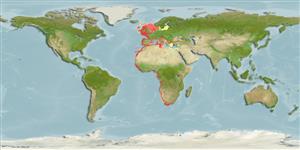Classificação / Names
Common names from other countries
Referência principal
Tamanho / Peso / Idade
Max length : 20.0 cm SL macho/indeterminado; (Ref. 189); common length : 13.5 cm SL macho/indeterminado; (Ref. 189); Peso máx. publicado: 0.00 g; Idade máx. registada: 5 anos (Ref. 92145)
Length at first maturity
Lm 9.7, range 9 - 14 cm
Ambiente
; marinhas; estuarina; oceanódromo (Ref. 51243); intervalo de profundidade 0 - 400 m (Ref. 2683)
Clima / Intervalo
Subtropical, preferred 21°C (Ref. 107945); 62°N - 37°S, 18°W - 42°E (Ref. 54230)
Distribuição
Eastern Atlantic: Bergen, Norway to East London, South Africa (perhaps reaching Durban) (Ref. 10000). Also all of Mediterranean, Black and Azov seas, with stray individuals in Suez Canal and Gulf of Suez; also recorded from St. Helena (Ref. 189). Reported from Estonia (Ref. 33247).
Países | Áreas FAO | Ecossistemas | Ocorrências | Introduções
Descrição breve
Espinhos dorsais (total): 0; Raios dorsais moles (total): 16-18; Espinhos anais 0; Raios anais moles: 13 - 15; Vértebras: 46 - 47. Snout pointed; maxilla short, tip blunt, reaching almost to front border of pre-operculum, not projecting beyond tip of second supra-maxilla; tip of lower jaw reaching almost to below nostril. Gill rakers present on hind face of third epibranchial. Pseudobranch longer than eye, reaching onto inner face of operculum. A silver stripe along flank, disappearing with age.
Categoria na Lista Vermelha da IUCN (Ref. 115185)
Ameaça para o homem
Harmless
Utilização humana
Pescarias: altamente comercial; isco: usually
Ferramentas
Relatórios especiais
Descarregue XML
Fontes da internet
Estimates of some properties based on models
Phylogenetic diversity index
PD50 = 0.5020 many relatives (e.g. carps) 0.5 - 2.0 few relatives (e.g. lungfishes)
Nível Trófico
3.1 ±0.36 se; Based on food items.
Resiliência
Médio, tempo mínimo de duplicação da população 1,4 - 4,4 anos (K=0.3-1.73; tmax=6; Fec =13,000-503,000)
Vulnerabilidade
Low vulnerability (25 of 100)
Categoria de preço
